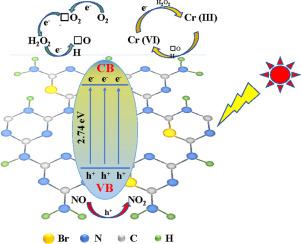当前位置:
X-MOL 学术
›
Chin. J. Catal.
›
论文详情
Our official English website, www.x-mol.net, welcomes your
feedback! (Note: you will need to create a separate account there.)
Br-doping of g-C3N4 towards enhanced photocatalytic performance in Cr(VI) reduction
Chinese Journal of Catalysis ( IF 15.7 ) Pub Date : 2020-10-01 , DOI: 10.1016/s1872-2067(19)63435-2 Mian Wang , Yubin Zeng , Guohui Dong , Chuanyi Wang
Chinese Journal of Catalysis ( IF 15.7 ) Pub Date : 2020-10-01 , DOI: 10.1016/s1872-2067(19)63435-2 Mian Wang , Yubin Zeng , Guohui Dong , Chuanyi Wang

|
Abstract Semiconductor photocatalytic technology is widely recognized as one of the most promising technologies to solve current energy and environmental crisis, due to its ability to make effective use of solar energy. In recent years, graphite carbon nitride (g-C3N4), a new type of non-metallic polymer semiconductor photocatalyst, has rapidly become the focus of intense research in the field of photocatalysis because of its suitable bandgap energy, unique structure, and excellent chemical stability. In order to improve its intrinsic shortages of small specific surface area, narrow visible light response range, high electron-hole pair recombination rate, and low photon quantum efficiency, a simple method was utilized to synthesize Br-doped g-C3N4 (CN–BrX, X = 5, 10, 20, 30), where X is a percentage mole ratio of NH4Br to melamine. Experimental results showed that Br atoms were doped into the g-C3N4 lattice by replacing the bonded N atoms in the form of C–N=C, while the derived material retained the original framework of g-C3N4. The interaction of Br element with the g-C3N4 skeleton not only broadened the visible-light response of g-C3N4 to 800 nm with an adjustable band gap, but also greatly promoted the separation efficiency of the photogenerated charge carrier and the surface area. The photocurrent intensity of bare CN and CN–BrX (X = 5, 10, 20, 30) catalysts is calculated to be 1.5, 2.0, 3.1, 6.5, and 1.9 μA, respectively. And their specific surface area is measured to be 9.086, 9.326, 15.137, 13.397, and 6.932 m2/g. As a result, this Br-doped g-C3N4 gives significantly enhanced photocatalytic reduction of Cr(VI), achieving a twice enhancement over g-C3N4, with high stability during prolonged photocatalytic operation compared to bare g-C3N4 under visible light irradiation. Furthermore, an underlying photocatalytic reduction mechanism was proposed based on control experiments using radical scavengers.
中文翻译:

g-C3N4 的 Br 掺杂提高了 Cr(VI) 还原中的光催化性能
摘要 半导体光催化技术由于能够有效利用太阳能,被广泛认为是解决当前能源和环境危机最有前途的技术之一。近年来,石墨氮化碳(g-C3N4)作为一种新型的非金属高分子半导体光催化剂,以其适宜的带隙能量、独特的结构和优异的化学性能迅速成为光催化领域研究的热点。稳定。为了改善其固有的比表面积小、可见光响应范围窄、电子-空穴对复合率高和光子量子效率低的固有缺陷,采用一种简单的方法合成了 Br 掺杂的 g-C3N4(CN-BrX , X = 5, 10, 20, 30),其中 X 是 NH4Br 与三聚氰胺的摩尔比百分比。实验结果表明,Br原子通过取代键合的N原子以C-N=C的形式掺杂到g-C3N4晶格中,而衍生材料保留了g-C3N4的原始骨架。Br元素与g-C3N4骨架的相互作用不仅将g-C3N4的可见光响应拓宽至800 nm,带隙可调,而且大大提高了光生载流子和表面积的分离效率。裸 CN 和 CN-BrX (X = 5, 10, 20, 30) 催化剂的光电流强度分别计算为 1.5、2.0、3.1、6.5 和 1.9 μA。它们的比表面积测量为 9.086、9.326、15.137、13.397 和 6.932 m2/g。因此,这种 Br 掺杂的 g-C3N4 显着增强了 Cr(VI) 的光催化还原,实现了 g-C3N4 的两倍增强,与可见光照射下的裸 g-C3N4 相比,在长时间的光催化操作中具有高稳定性。此外,基于使用自由基清除剂的控制实验,提出了潜在的光催化还原机制。
更新日期:2020-10-01
中文翻译:

g-C3N4 的 Br 掺杂提高了 Cr(VI) 还原中的光催化性能
摘要 半导体光催化技术由于能够有效利用太阳能,被广泛认为是解决当前能源和环境危机最有前途的技术之一。近年来,石墨氮化碳(g-C3N4)作为一种新型的非金属高分子半导体光催化剂,以其适宜的带隙能量、独特的结构和优异的化学性能迅速成为光催化领域研究的热点。稳定。为了改善其固有的比表面积小、可见光响应范围窄、电子-空穴对复合率高和光子量子效率低的固有缺陷,采用一种简单的方法合成了 Br 掺杂的 g-C3N4(CN-BrX , X = 5, 10, 20, 30),其中 X 是 NH4Br 与三聚氰胺的摩尔比百分比。实验结果表明,Br原子通过取代键合的N原子以C-N=C的形式掺杂到g-C3N4晶格中,而衍生材料保留了g-C3N4的原始骨架。Br元素与g-C3N4骨架的相互作用不仅将g-C3N4的可见光响应拓宽至800 nm,带隙可调,而且大大提高了光生载流子和表面积的分离效率。裸 CN 和 CN-BrX (X = 5, 10, 20, 30) 催化剂的光电流强度分别计算为 1.5、2.0、3.1、6.5 和 1.9 μA。它们的比表面积测量为 9.086、9.326、15.137、13.397 和 6.932 m2/g。因此,这种 Br 掺杂的 g-C3N4 显着增强了 Cr(VI) 的光催化还原,实现了 g-C3N4 的两倍增强,与可见光照射下的裸 g-C3N4 相比,在长时间的光催化操作中具有高稳定性。此外,基于使用自由基清除剂的控制实验,提出了潜在的光催化还原机制。











































 京公网安备 11010802027423号
京公网安备 11010802027423号